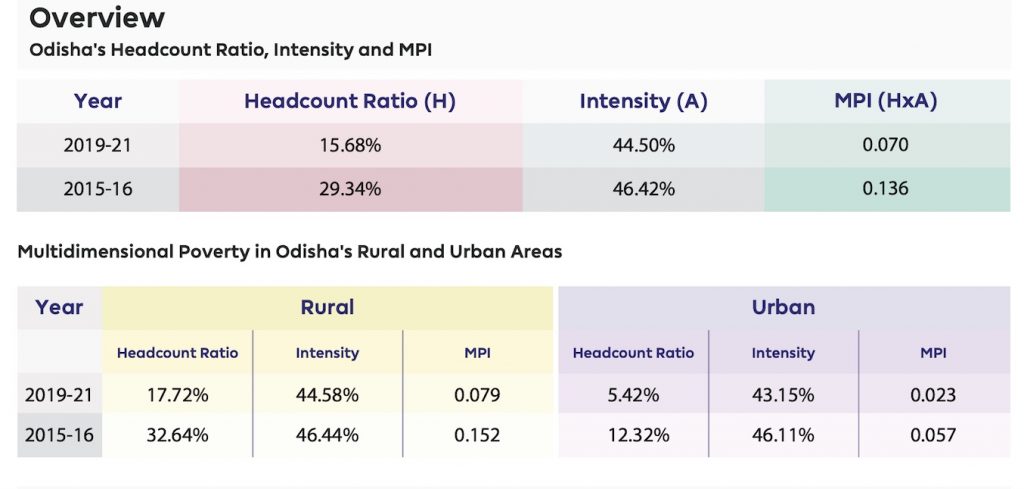Bhubaneswar: Odisha is among five states that saw steepest decline in the number of multidimensionally poor, contributing to the fastest decrease in poverty in rural areas from 32.59% to 19.28% between 2015-16 and 2019-2021, according to the ‘National Multidimensional Poverty Index: A Progress Review 2023’.
The other states are Bihar, Uttar Pradesh, Madhya Pradesh, and Rajasthan.
“The estimates indicate that rural areas saw a faster reduction in their MPI value, compared to urban areas. The incidence of poverty fell from 32.59% to 19.28% in rural areas compared to a decline from 8.65% to 5.27% in urban areas between 2015-16 and 2019-21.”
India has registered a significant decline of 9.89 percentage points in the number of multidimensionally poor, from 24.85% to 14.96% during this period. The number of states with less than 10 per cent people living in multidimensional poverty doubled in these five years. In 2015-16 (NFHS-4), only seven states, Mizoram, Himachal Pradesh, Punjab, Sikkim, Tamil Nadu, Goa, and Kerala, had less than 10 per cent of their population living in multidimensional poverty. Seven more states, Telangana, Andhra Pradesh, Haryana, Karnataka, Maharashtra, Manipur, and Uttarakhand, were added to the list in 2019-21 (NFHS-5).
Delhi, Kerala, Goa and Tamil Nadu have the least number of people facing multidimensional poverty along with the Union Territories. Bihar, Jharkhand, Meghalaya, Uttar Pradesh and Madhya Pradesh, where the percentage of multidimensionally poor is high, top the chart.
Odisha features at the eighth position from the bottom. The percentage of people living under multidimensional poverty in the state has, however, decreased from 29.34 to 15.68.
Malkangiri has the most poor at 45.01%, which is a decrease from 58.66% in 2015-16, followed by Rayagada (from 48.14% to 34.03%), Koraput (from 51.14% to 33.54%), and Nabarangpur (from 59.32% to 33.45%). Puri (3.26%), Jagatsinghpur (3.53%), Khurda (3.95%), Cuttack (6.31%) and Ganjam (6.31%) have the least number of people facing multidimensional poverty. Nayagarh, Jharsuguda, Sonepur, Kendrapada and Balangir also have poverty rate below 10%.

The disaggregated estimates show that the most rapid reduction in the proportion of multidimensionally poor individuals occurred in districts located within the states of Madhya Pradesh, Gujarat, Uttar Pradesh, and Rajasthan.
Collectively, India has lifted approximately 13.5 crore people out of multidimensional poverty in the same period. In 2015-16, one in four Indians (24.85 per cent) met the criteria for multidimensional poverty. By 2019-21, this percentage decreased to 14.96 per cent, or one in seven, the report, which examines three broad indicators of multidimensional poverty — health, education, and standard of living, each comprising various sub-indicators, said.
This indicates that India is well on course to achieve the SDG target 1.2 much ahead of 2030. At the same time, the Intensity of Poverty, which measures the average deprivation among the people living in multidimensional poverty, also reduced from 47.14% to 44.39%, it added.


